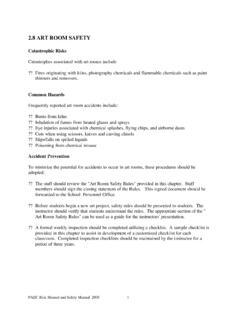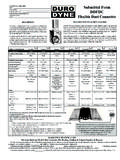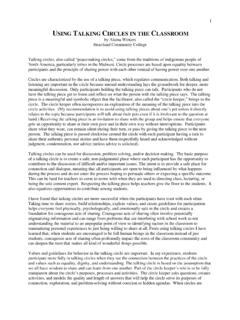Transcription of Elements of Surface and Deep Culture Surface Culture
1 Elements of Surface and deep Culture The following examples are meant to demonstrate cultural diversity and should NOT be considered true for all members of a cultural group. Surface Culture : Foods includes foods and eating patterns/habits Holidays patriotic, religious observations, personal rites and celebrations Arts visual and performing arts, music and drama Folklore myths, fables, legends, fairy tales, folk songs, proverbs, riddles, jokes, limericks, verses, rhymes, and games History historical and humanitarian contributions, social and political movements Personalities historical, contemporary, and local figures deep Culture : Ceremony (What a person is to say and do on particular occasions). o Some cultures teach children to shake hands with adults as an appropriate greeting. However, within many Asian cultures, body contact is not practiced. Greetings are expressed by bowing the head slightly. o Eye contact between the teacher and the student is expected in most schools.
2 However, in many cultures it is considered disrespectful to look the teacher in the eye, because the adult is a figure of authority. o When a teacher congratulates a Vietnamese student for doing something very well, the person may say that he or she is not really good at all. This is not false modesty, but only an example of the Confucian concept of reacting with modesty to praise, which has been practiced for more than two millennia. Courtship and Marriage (attitudes toward dating, marriage and raising a family). o Today, most persons have a choice in choosing their mates; however, within some Arab and East Indian cultures, marriages are still arranged through mutual consent of both families. o Among some Asian cultures, wives assume a subordinate role to their husbands in all areas after marriage. They have no legal or marital rights and must obey their husbands. In the event of the husband's death, this obedience must transfer to the eldest son. o Community property laws, where women are entitled to half of men's wealth after marriage, come from Spanish law.
3 Not all 50 states have community property laws. The majority of the states with such laws are found in the Southwest because of the Spanish influence in this area. o The upper and middle classes in Haiti follow the Western pattern of formal marriage. The vast majority of less affluent Haitians follow the marital pattern of placage, a form of common-law marriage. This is a union which may last for life. Aesthetics (the beautiful things of Culture : literature, music, dance, art, architecture, and how they are enjoyed). o What is considered beautiful in one Culture may be considered unattractive in another. Some cultures will not use complementary colors on the color wheel together, , red and green, while other cultures consider this juxtaposition as beauty. o Some cultures emphasize the subdued and the miniature while others prefer things that are large. For example, the value placed on miniature objects within Asian cultures is represented by the centuries-old practice of bonsai, the cultivation of dwarfed plants.
4 O Some Native American tribes have seven words for the color blue. Who would argue that the blue of the sky is the same as the blue of the ocean ? o Some cultures value items that are made by hand more than items which are made by machine. This explains why a handmade gift item, regardless of how primitive it may seem to one, is received with extreme admiration in some cultures. o The adage beauty is in the eye of the beholder remains true today. All people learn to appreciate the things they see through their own cultural eyes. Ethics (how a person learns and practices honesty, fair play, principles, moral thought, etc.). o How cultures practice honesty, fair play and moral principles may differ. What some classroom teachers consider cheating may be viewed as helping one another from another cultural point of view. o The concepts of good and evil for the Vietnamese are part of the mainstream of life. Living consists of successfully existing or surviving, as best as one can.
5 Authority is recognized more readily when it has a human face. The law is understood better when it is represented by a person. Allegiance, political or otherwise, is usually to a human being rather than to an abstract principle or idea. o In the Lao Culture , to be adult is to be totally independent, self-sufficient and self-reliant. Family ties (how a person feels towards his or her family, friends, classmates, roommates, and others). o Bonding is different among different cultures. In some cultures, for example Hawaiian and Mexican migrant, older children, regardless of gender, are typically expected to care for younger children. o Some cultures practice multiple generation housing patterns. Three, four, or five generations may live as one family unit. o Extended family relationships exist in many cultures. First and second generation relatives may be considered as important as siblings. o The family nucleus is the center of Haitian life, this includes all relatives. The family deals with all aspects of a person's life, and everything is considered within their domain.
6 Handling crises, counseling, healthcare, marriage, travel, and educational decision-making are all included. Religion is primarily family- oriented in that all interaction and worship patterns are conducted as family, not individual, endeavors. Health and Medicine (how a person reacts to sickness, death, soundness of mind and body, medicine, etc.). o Natural medicines are used by many cultures. Teas made from roots, bark and leaves of a plant are used today as they have been for centuries. Scientists are continually discovering the chemical bases for the effectiveness of these natural medicines. o Folk medicine is practiced by some cultures. Curanderismo, the practice of using folk healers, continues among some Hispanics. Curanderas or curanderos practice the gift of healing through natural remedies, superstition and religion. o Coining (Cao gio) is a common practice in Asian countries. A coin dipped in mentholated oil is vigorously rubbed across the skin in a prescribed manner, causing a mild dermabrasion.
7 This practice is believed to release the excess force wind from the body to restore balance. You may access the following web site for a picture of coining. o Cupping (Giac) - A series of small, heated glasses are placed on the skin, forming a suction that leaves a red circular mark, drawing out the bad force. o Pinching (Bat gio) - Similar to coining and cupping, the dermabrasion formed by pinching the skin allows the force to leave the body. (It should be noted that many of these practices are performed on young children, even infants, and the temporary dermabrasions they produce should not be confused with abuse or injury.). Folk myths (attitudes toward heroes, traditional stories, legendary characters, superstitions, etc.). o Every Culture has folk myth practices. For example, among some Hispanic groups, hiccups may be cured by making a small ball of red thread, moistening it with saliva and placing it on the forehead of the child. In contemporary Culture , many groups believe a sudden fright will cure hiccups.
8 Some Asian cultures cure colds by rubbing the skin with a coin until bruises appear. o Every Culture has its distinctive omens. In some groups, the dropping of an eating utensil foretells the arrival of someone who is hungry, or walking under a ladder signifies bad luck. The owl is considered a bad omen among some Hispanics, Asians and Middle Easterners and may represent bad luck, evil, or stupidity. In many Vietnamese homes, the first visitor to one's home on New Year's Day is an omen of how the coming year will be filled with happiness if the visitor is a prosperous one. If the person is gruff or drunk, the year will bring misfortune. o Regional differences exist across cultures. Many homes in the South serve black- eyed peas on New Year's Day to bring good luck during the coming year, although these may be considered livestock feed and not fit for human consumption by people residing in the midwest . Gestures and Kinesics (form of nonverbal communication or reinforced speech, such as the use of the eyes, the hands, and the body).
9 O Body language in one Culture may mean something completely different in another. Directions in the generally are indicated by pointing with the index finger. In other cultures, this same gesture may have crude or unacceptable connotations. o The hand signal indicating come here used by Americans, wiggling the index finger toward the body, may be an insulting gesture to some Asians since it is used only with dogs or cats. o Americans indicate that something is perfect by touching the index finger and thumb. In Vietnam, this gesture means worthless.. Grooming and Presence (the cultural differences in personal behavior and appearances, such as laughter, smile, voice quality, gait, poise, hair style, cosmetics, dress, etc.). o The manner in which one dresses is culturally determined and may also be affected by socioeconomic factors. Some immigrants to the United States use their traditional dress at times and American clothes at others. Often the use of traditional dress is due to the costliness of replacing one's native wardrobe with American clothes.
10 O Cultural presence is also evident in the way people appear, their gait, their stance, and their posture. For example, a woman who walks rapidly may be considered extremely unladylike in some cultures, whereas TV commercials in the United States imply this is a sign of valued vibrancy. o Adornment of the ears is considered a mark of beauty in some cultures. Some groups pierce the ears of females during infancy. Other groups may pierce their nostrils for adornment purposes. Ownership (attitudes toward ownership of property, individual rights, loyalties, beliefs, etc.). o All cultures teach a sense of ownership, but to varying degrees. Among Native Americans, land was not to be owned or abused. It was only to be used to provide for one's immediate need. o Some cultural groups would find it rude to accept an offer immediately. They believe offers must be politely refused several times before accepting. Precedence (what are accepted manners toward older persons, peers and younger persons).






